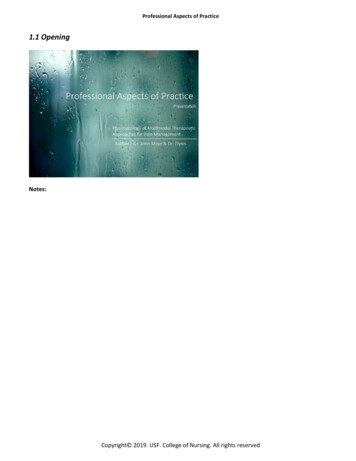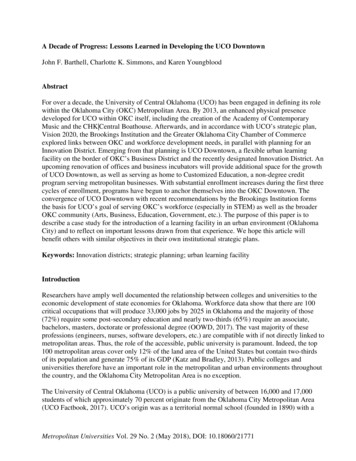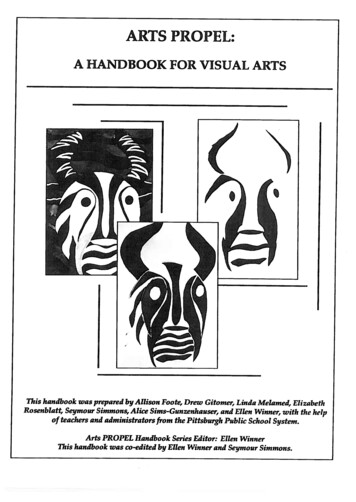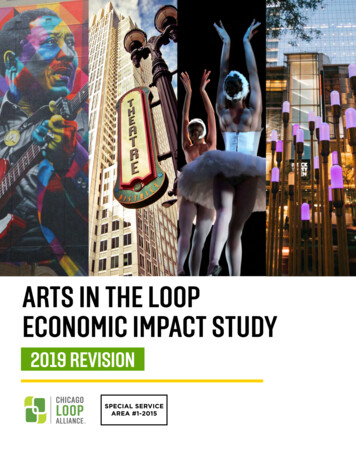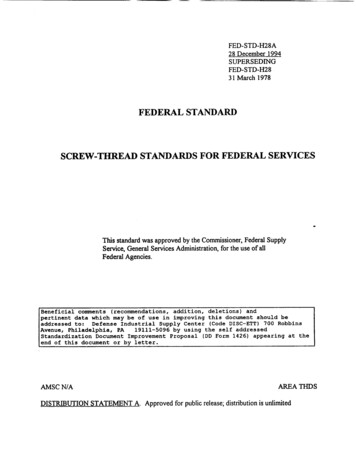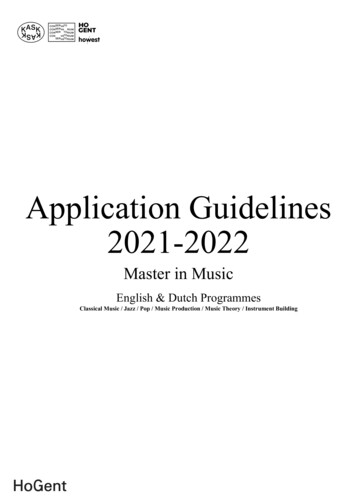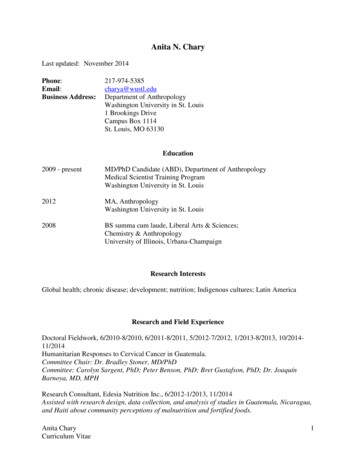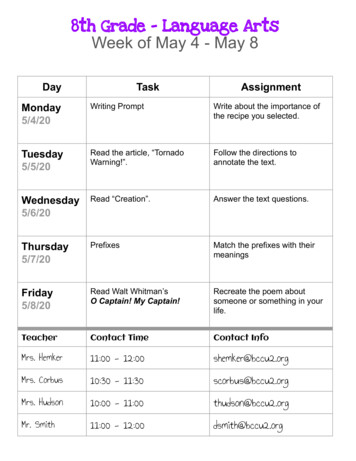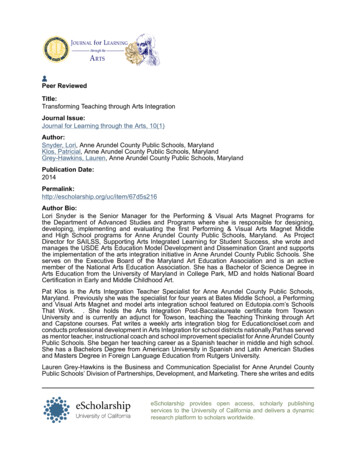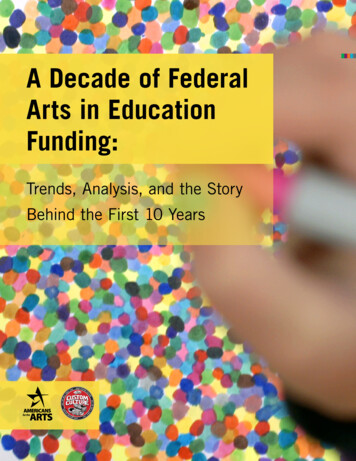
Transcription
A Decade of FederalArts in EducationFunding:Trends, Analysis, and the StoryBehind the First 10 Years
2A Decade of Federal Arts in Education Funding: Trends, Analysis, and the Story Behind the First 10 YearsTable of Contents3Acknowledgement4The Background6The Story Behind the Story9Common Threads in All Reports10Basic Grantee Data11Students Served14Recurring Themes16Leadership Engagement17Instructional Quality23Dissemination24Grant Impact26Lessons Learned28Implementation Challenges31Course Corrections37Evaluation Challenges40Recommendations from Grantees42Conclusion44Evaluation Design45Future x
gementThrough a partnership with Vans Custom Culture, Americans for the Arts has designeda series of tools and publications to help educators, advocates, students worktogether to ensure that the arts are valued in our country as an important part of allstudents’ lives.Vans Custom Culture has provided critical resources to support the development andlaunch of this publication, which highlights what we’ve learned from a decade offederally supported arts education programs throughout the country.To find more information about Americans for the Arts’ tools and resources in artseducation, please visit our website.3
4A Decade of Federal Arts in Education Funding: Trends, Analysis, and the Story Behind the First 10 YearsThe BackgroundIn this section, we’ll cover whatthe U.S. Department of Education’sArts in Education program is, howit works, and who it serves. Geta quick overview of the grantees,the students they served, and afew stories from the program’sfirst 10 years to give you an ideaof the types of arts integrationmodels the grantees designed.
5www.AmericansForTheArts.org/ArtsEducationThe Story Behind the Story6Common Threads in All Reports9Basic Grantee Data10Students Served11
6A Decade of Federal Arts in Education Funding: Trends, Analysis, and the Story Behind the First 10 YearsThe Story Behind the StoryThe only dedicated federal funding source for arts education is through the U.S.Department of Education’s Arts in Education (AIE) program. When Congress approvedthe No Child Left Behind Act of 2002, it authorized the Arts In Education programto pursue “disseminating information about model school-based arts educationprograms.” Since 2002, Congress has approved about 448 million for the Arts inEducation program, and of that total, at least 5 million was targeted for disseminationand evaluation specifically.The AIE program is dedicated to improving learning in high-poverty schools throughthe arts. The program is comprised of four key components:1. Model Development and Dissemination (AEMDD) Grants,which focus on arts integration programs for students.2. Professional Development for Arts Educators (PDAE) Grants, whichdevelop models to improve the teaching of both arts specialists andgeneral classroom teachers through arts learning strategies.3. A National Activities Fund, which supports national-level arts educationprojects, focusing on low-come families and students with disabilities.4. Evaluation and National Dissemination, which is intendedto multiply the impact of this federal investment.Since its inception in 2002, the AIE program has received an average appropriationof 32 million per year through the U.S. Department of Education’s budget, witha high of 40 million in 2010 and a low of 23.6 million in 2013 due to sequestration. 40m 35m 30m 25m �11‘12‘13‘14
www.AmericansForTheArts.org/ArtsEducationSince grants have a three-year cycle, the lower budget amounts mean that newgrantees can only be added when current grantees have finished their cycle.Americans for the Arts has long advocated on behalf of the Arts inEducation program. (For more details about why we support the program,you can read our Legislative Issue Brief.) As part of that advocacy, we’veoften asked the Department to release any information about the resultsof the grants. After all, a major component of the AIE program is calleda “model development dissemination grant.” However, even though theAIE program had been running for over a decade, no reports had beenreleased by the Department on the progress of the grantees. Moreover,because of the Department’s archiving rules, the research and reportsfrom the AIE program’s early years were to be destroyed in 2012. In orderto save these reports, Americans for the Arts executed a Freedom ofInformation Act (FOIA) request—the largest in this program’s history—toreceive copies of the research before its destruction.For moredetails onfederal artseducationfunding,read ourLegislativeIssueBrief.Americans for the Arts requested access to the final evaluation reports that theAEMDD and PDAE grantees submitted to the Department of Education. While thegrantees completed their reports without intending them as public documents, theybecame just that—and very valuable ones. Wanting to get a glimpse of what our fieldmight have learned from the AIE program, Americans for the Arts hired an externalevaluator, Yael Silk, to analyze about eight large boxes of paperwork from 10 yearsof the Department’s archives. In total, our evaluator received 148 reports.Given the amount of diversity among the grantees, both in terms of program andevaluation design, our final analysis focuses on 84 evaluation reports included in thedata set. After a decade of hundreds of organizations participating in these competitivearts education grants, there had been very little national dissemination relating to thesuccesses, and shortcomings, of these efforts—until now. We embarked on analyzingthis information so that we could disseminate what our field has learned from the7
8A Decade of Federal Arts in Education Funding: Trends, Analysis, and the Story Behind the First 10 Yearslargest investment in arts education that the federal governmentAn external evaluatoranalyzed 10 years’worth of paperworkfrom USDE archives.has ever made.As you read through the story of this grant program, we hope thatthis paper will:»» Capture compelling vignettes and larger themes withinOur final analysisfocuses on84 evaluationreports submitted»» Identify strategies for addressing these challenges; andby AEMDD and»» Help readers walk away with new ideas about art integrationPDAE grantees.a data set focused on arts integration partnerships;»» Consider what makes evaluating these types of programsso challenging;partnerships and a strong belief that these types of programsare important and doable.But, please keep the following in mind:»» Not all grantees are represented in this sample because theirfinal evaluation reports were physically not included amongthe mailed files from the Department of Education.»» Grantees wrote these evaluation reports for the U.S. Department ofEducation, not an external audience; therefore the language describingthe interventions themselves ranges widely in their level of specificity.»» Each grantee and their independent evaluation teamidentified their own method for measuring success andused varying language to describe these indicators.»» Limited reporting guidelines by the U.S. Department ofEducation for the final reports resulted in a wide range ofreporting styles, making comparisons difficult.We hope you enjoy reading the history of the U.S. Department of Education’sArts in Education program and enjoy seeing just how far our field has come.
www.AmericansForTheArts.org/ArtsEducationCommon Threads in All ReportsThroughout these 84 reports, we found and categorized recurring themes relatingto students served, leadership engagement, instructional quality, dissemination,implementation challenges, course corrections, and evaluation challenges. At thebeginning of each section, you’ll see how many reports we sourced these topics from,as well as how many times the topic was mentioned. Here’s a visual representation ofthe frequency we saw these themes mentioned across the reports.CourseCorrectionsLeadershipEngagement49 mentionsStudentsServed53 mentions92 mentionsInstructionalQuality91 mentionsDissemination89 mentionsEvaluationChallenges47 mentionsImplementationChallenges94 mentions9
10A Decade of Federal Arts in Education Funding: Trends, Analysis, and the Story Behind the First 10 YearsBasic Grantee DataThe U.S. Department of Education (USDE) has been awarding ProfessionalDevelopment in Arts Education (PDAE) and Arts Education Model Developmentand Dissemination (AEMDD) grants for more than a decade now. The grant criteriarequired programs to focus on arts integration (with a focus on language arts andmath) and the AEMDD grants needed to use state or district testing data as onemeasure of success. From the beginning, grantees were required to allocate a portionof the funds to work with an external evaluator. Each grantee submitted annual andfinal evaluation reports to the USDE.This study includes 84 of these final evaluation reports. Of these, 49 are for AEMDDgrants and 35 are for PDAE grants. Each grant was awarded across a three-yearperiod. The average amount was more than 700,000 and funded initiatives in 23states. Grantees offered programs across all art forms, including media and folk arts,and often offered multiple art forms. Programs in this analysis reached studentsPre-K–12, with the largest percentage of initiatives serving grades 3–5.Number of USDE Grantees Represented in This ReportGrant TypeAEMDD49PDAE35Total84MN8MI3Grantee TypeOther Arts & Cultural OrganizationPAUniversity1Arts Council2County Office of Education5Museum & Visual Arts Organization5Performing Arts Organization7Education Nonprofit13School 31KYSC2DCVA1AZMANY42CT3NJ44
s Served(sourced from 43 evaluation reports; 92 mentions)One of the absolute priorities of the grant application was the requirement thatprograms serve “at least one school with a poverty rate of 35 percent or higher.”Here are some of the ways that grantees described the schools, communities, andstudents that they served.How grantees describe the particular population they serve:No. of evaluation reports:low income / disadvantaged socioeconomic backgrounds / impoverished18recipients of Free / Reduced Lunch11ELL / ESL11at risk of academic failure / low achieving / low performing / educationally disadvantaged10at-risk9diverse cultural / ethnic backgrounds / minorities7special needs5health disparity2struggling readers2abuse victims1How grantees describe the communities these students live in and schools they attend:No. of evaluation reports:8Title 1 Schools5rural4inner-city/urban2high risk population/school2immigrant population2transient2high crime1Program Improvement designation1apathy toward education1culturally impoverished
12A Decade of Federal Arts in Education Funding: Trends, Analysis, and the Story Behind the First 10 YearsGrantees were careful to employ specific strategies to more effectively serve thestudent population that was involved in the grant program. Three specific strategieswere the most common among grantees:1. Implement art programs with a multicultural emphasis, sometimes usingfolk arts and/or relying on local community artists as resources.2. Focus on first engaging students and then building their emotional skillsincluding their self worth, sense of self, and ability to communicate with others.3. Teaching persistence by building art skills with alonger-term end result/project in mind.Given the focus on low income, at-risk, and ELL student populations, here are afew descriptions of programs (taken directly from reports) that describe how theseprograms were uniquely designed for the specific population of students.An in-depth qualitative study was undertaken with seven lower socio-economic status (SES) studentsat one of the AAEP schools. Findings showed that students from low SES backgrounds spoke aboutthe arts giving them the freedom to be seen and heard in ways that they otherwise felt silent;Students’ individual sense of themselves as learners was expanded by arts-based approaches toknowing; Students perceived that teachers who did bring the arts into their learning were moreaware of their interests and skills and they felt known and respected the most by those teachers;When asked to draw or otherwise express similar sources of knowledge, the low SES students feltmore understood and therefore more confident in their capacities for communications.Appalachian Arts inEducation PartnershipBoone, NC2002–2006
13www.AmericansForTheArts.org/ArtsEducationTrenton families are notoriously transient. Classroom teachers reported notable easing of tensionfor young students transferring mid-year when they discovered the familiar songs of the MVYMusic Together curriculum in their new classroom. Music in the urban classroom provideschildren with a safe emotional outlet and greater means of personal expression. That the MVYproject also provided curricular alignment across the district was a welcome, unexpectedoutcome. This was enhanced by the involvement of the district music teachers who employedMVY materials in the classrooms. Teachers reported their Spanish speaking children frequentlyused MVY materials as a bridge to English speaking. It was noted frequently that childrencomfortably engaged in signing English before they were prepared to speak English. In reverse,the Spanish songs in the collection provided comfortable, communal opportunities for the nonSpanish speaking children to communicate in Spanish.Since the primary issues for special needs students are under-developed linguisticskills and a lack of social skills necessary for effective peer-to-peer and student-teacherinteraction, we strived to address these special needs first and foremost. [Intervention hasstudents create and perform an original musical.] Teachers have reported to us that theirstudents gained confidence with public speaking, had improved communication skills,and learned to work collaboratively, both with their peers and with teachers and teachingartists. They also reported that their students became unafraid to contribute creativeideas and have developed an increased attention span and ability to listen to instructions.Theater exercises also helped students to become more comfortable with their classmatesand developed techniques that were used the final performances. Furthermore, teachersfelt that the writing process, which included the writing of the script and of song lyrics,benefited the students’ language skills tremendously.Creative and Integrative Arts EducatorsNew York, NY2005–2008Music for theVery YoungTrenton, NJ2007
14A Decade ofof FederalFederal BehindBehindthetheFirstFirst10 10YearsYearsRecurring ThemesHere are more details on how the grantprograms impacted the schools andstudents they served. As you read,keep the following questions in mind: What are the benefits of workingtogether and what are the challenges? How does striving to create learningcommunities around the arts impacteducators and their students?
hip Engagement16Instructional Quality17Dissemination23Grant Impact24
16A Decade of Federal Arts in Education Funding: Trends, Analysis, and the Story Behind the First 10 YearsLeadership Engagement(sourced from 29 evaluation reports; 49 mentions)Nearly all grantees wrote that support from their school leaders was a prerequisite toengaging in this kind of work. For example, school leaders and administrators are theones with the ability to create flexibility in the school schedule. Supportive leaderswould schedule time for collaborative planning between artists and teachers, andmany grantees cited this as a key to success in these types of efforts.When a school’s evaluation report described leadership in greater detail, it discussedboth leadership at the administrator level (principal, assistant principal, school board,superintendent, etc.) and also at the classroom level (instructional staff, teachers,or grade level team leaders). Ultimately, grantees who described specific leadershipengagement strategies typically geared these toward developing teacher leadersrather than principals or other administrators.Administrators were most likely engaged by attending, participating in, and/or observingaspects of professional development activities. Here are some additional examples ofexplicit leadership development/engagement strategies cited in the reports:»» Regional principals/coordinators participated in a retreat together.»» Program personnel initiated multiple communications with leadersaround site visits, leadership training, and networking opportunitiesfor teachers.»» Principals, administrators, and community partners participated ina needs assessment survey.»» Assistant principals trained in classroom observation protocol andan initial cohort piloted the instrument and provided feedback.»» When designing professional development, administratorsinvolved instructional staff.»» Project director engaged school board members as partners indisseminating findings at national and statewide presentations.
hools developed an arts committee including the schoolcoordinator, art specialists, classroom teachers, art organizationpartners, and sometimes parents.»» Schools had a single liaison between the school and the project director.»» Assistant superintendent identified which grades would be servedand with which curriculum.These activities for principals, superintendents, and school board members providedleadership support for each grant program—everything from instructional leadershipto allocation of much needed resources. The very act of principals and administratorsparticipating in planning retreats or completing surveys signaled to teachers andstudents that the grant program was of value to the school.Instructional Quality(sourced from 38 evaluation reports; 91 mentions)Instructional quality was frequently referenced, but those references were not onlyabout what was being taught, but also how it was being taught, how the teacherslearned to teach it, and how that instruction was evaluated.Grantees that defined what they meant by “quality arts instruction” often identifiedresearch-based teaching methods in the arts as examples, such as Visual ThinkingStrategies or Habits of Mind. Many grantees then named the specific teachingstrategies that served as guideposts for their program implementation and evaluation.Two examples are:»» Clear intention when selecting what and how to integrate the arts—content,skills, pacing, assessment, inclusion of the art specialist and teaching artist.»» Teaching through Big Ideas and inquiry questions, process documentation,student assessment, open-ended questioning, and critical thinking.17
18A Decade of Federal Arts in Education Funding: Trends, Analysis, and the Story Behind the First 10 YearsThroughout the Arts Initiative Series, reflective practice in interdisciplinary instruction was bothmodeled by the teacher leaders during their hands-on demonstration units, as well practiced bythe participants during each day of the Series and during the design and implementation oftheir interdisciplinary arts unit. Two of the six strands, goals, and enduring understandings ofthe curriculum reinforced and augmented this practice.The analysis of the reports showed that implementation of quality arts instruction fellSanta ClaraCounty Officeof EducationArts in theClassroomProfessionalDevelopmentProgramSan Jose, CA2007into the following five components that we’ll discuss below:1. Curriculum – what was being taught2. Shared teaching practice – how it was being taught3. Professional development – how teachers learned t
Development in Arts Education (PDAE) and Arts Education Model Development and Dissemination (AEMDD) grants for more than a decade now. The grant criteria required programs to focus on arts integration (with a focus on language arts and math) and the AEMDD grants needed to use state or district

